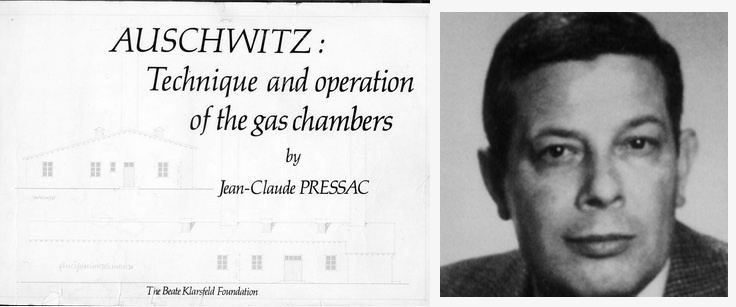Name Jean-Claude Pressac Role Chemist | Died July 23, 2003 | |
 | ||
Jean-Claude Pressac (c. 1944 – 23 July 2003) was a French chemist and pharmacist by profession, who became a published authority on the Auschwitz concentration camp homicidal gas chambers deployed during the Holocaust in World War II. He is the author of the 1989 book Auschwitz: Technique and operation of the gas chambers among other publications on the subject.
Contents

Pressac was originally a Holocaust denier who, with Robert Faurisson, attempted to disprove what he considered historically inaccurate depictions of the concentration camps as extermination camps. However, upon visiting Auschwitz in 1979 and 1980, Pressac was able to view first-hand the extensive archive of original German documents thanks to the courtesy of the museum staff and administration unaware of the true purpose of his research. In Poland, Holocaust denial is punishable by law.

Faurisson case

Prior to his visits at Auschwitz, Pressac, a French national, was instructed by Faurisson on how to go about conducting his onsite examinations in Oświęcim. He was warned against the tendency to see "falsehoods" everywhere. Instead, he was asked to study and photograph the ruins of crematoria in search of "false interpretations" of visible objects. Upon his arrival in Poland, Pressac believed that he was prepared to "revise" the official history of the camps.

Pressac visited Auschwitz Birkenau ten times between 1979 and 1984, according to registered letter from the Auschwitz Museum director Kazimierz Smoleń, sent on 11 September 1985. Pressac used only authentic documents concerning the construction of crematoria and the gas chambers, which originated from the Nazi German office of Zentral Bauleitung der Waffen SS. Museum staff provided him with assistance, convinced of his honourable intentions. Pressac was given access to blueprints which had survived due to being located in the construction office rather than the administrative offices. The analysis of material proof convinced him that his former views shaped by the Faurisson case were in error. He described his experience dramatically in the 'Postface' of Auschwitz: Technique and operation of the gas chambers, saying that he "nearly did away with [himself] one evening in October 1979 in the main camp, the Stammlager, overwhelmed by the evidence and by despair". Pressac wrote:
In September 1980, Faurisson and Guillaume came to my place to assess the value of what I had been able to pick up in the Auschwitz Museum. I had admittedly been able to take many photographs, which I thought would help Faurisson form a more concrete picture of the site, but I had not been able to bring back any documents ... verification meant trips to Poland and therefore extended over a period of months ... It was therefore decided to devote all efforts to demolishing the Auschwitz gas chambers. If we succeeded in removing this cornerstone of the Birkenau edifice, the rest would collapse with it. It was a desperate solution, but the only logical one compatible with our resources. Faurisson was forced to stake everything on it. I was to redouble my efforts studying the documents concerning the construction of the Krematorien in the hope of finding evidence that homicidal gas chambers had never been installed in these buildings. — Pressac 1989, p. 550
Holocaust publications
Pressac published his conclusions along with much of the underlying evidence in his 1989 book, Auschwitz: Technique and operation of the gas chambers by Beate Klarsfeld Foundation of New-York with translation from the French by Peter Moss.
In his 1993 Les Crématoires d'Auschwitz, he further delineated the operation of the crematoria at Auschwitz, and their integration into the larger Nazi program to eradicate the Jews of Europe. Pressac estimated that between 631,000 and 711,000 were killed at Auschwitz.
Criticism
His first 1989 book featuring the totality of Pressac's original research was a soft cover limited print already translated from French, sponsored financially by the Klarsfeld Foundation. It was a 564-page oblong 'coffee-table' book resembling a profusely illustrated building construction manual. The broader impact of his research was achieved only with the translated version of his second book titled The machinery of mass murder at Auschwitz : design, construction, use, modifications, and destruction of the crematoria and gas chambers which was published in 1993. Reporting from France for The New York Times, Roger Cohen wrote on 28 October 1993:
His recently published book, "The Auschwitz Crematoria: The Machinery of Mass Slaughter," has been alternately hailed in France as the definitive account of how the Nazis installed and operated their instruments of murder; and vilified, as the barren ruminations of a man with a twisted need to prove the massacre of Jews that he once doubted.
The book written by Pressac was a subject of Ron Rosenbaum's interview with Claude Lanzmann in Paris, conducted for his own book Explaining Hitler. Rosenbaum noted how much the 1985 release of the Lanzmann's controversial Shoah (film) "had raised him to the vatic, prophetic heights" from which he hurled criticism at others. Pressac was no exception. Lanzmann said:
What is the Pressac book? Pressac is a former Revisionist. He's convinced that the gas chambers did actually exist. And he's not discovering anything new in this. Absolutely nothing. He opens the door of the gas chamber. Everybody knew they were there. — Claude Lanzmann (in) Explaining Hitler by Ron Rosenbaum
